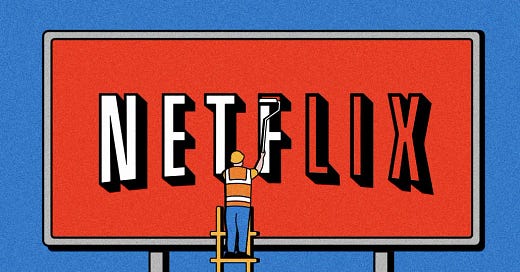Netflix's Attention Economy: How the Streaming Giant Really Wins
The product is attention. The business is retention.
In the latest shareholder letter, Netflix revealed another quarter with record subscriber growth, and their strategy is clearer than ever: Netflix isn't primarily a content company, but an attention company.
The Business Behind the Stream
Most industry analysts focus on Netflix's content slate, but their Q4 2024 shareholder letter reveals a more sophisticated business model. While Netflix spent a staggering $16.2 billion on content in 2024 (with $18 billion projected for 2025), the true product they're selling isn't shows or movies – it's engagement.
As Netflix explicitly states: "Engagement underpins that goal, as we believe it is the best proxy for customer satisfaction, which in turn leads to higher retention, acquisition and value for our service."
This insight reveals Netflix's true business model:
The medium is content
The product is attention
The business is retention
And their north star is engagement because it drives subscriber satisfaction, reduces churn, increases perceived value, and generates better returns on content investments.
The Metrics That Matter
Netflix's focus on engagement is evident in the metrics they highlight:
Daily engagement: Approximately 2 hours per paid membership per day
Membership growth: Record-breaking 19M new paid subscriptions in Q4
Cultural impact: Six of the top 10 most-searched TV shows globally on Google
Viewing leadership: More #1 shows and more total view hours in streaming charts than all competitors combined
Their most successful content demonstrates this strategy in action:
Squid Game Season 2: 165.7M views
Carry-On: 160.1M views (joined all-time Top 10 films)
Jake Paul vs. Mike Tyson: Most-streamed sporting event ever
NFL on Christmas Day: Two most-streamed NFL games in history
The Financial Connection
What makes Netflix truly exceptional is how they connect engagement directly to financial performance:
Content ROI: By tracking which shows and films drive the most engagement, Netflix optimizes content investment to maximize returns.
Optimized Amortization: Their approach to content amortization (how they spread content costs over time on financial statements) has become increasingly sophisticated. By analyzing viewing patterns, they can create more accurate amortization schedules that better reflect how content actually performs.
Data-Driven Decision Making: Every content investment is evaluated based on its potential engagement-to-cost ratio, reducing expensive "misses" and improving margin.
This has delivered impressive financial results:
Q4 2024 Revenue: $10.25B (16% year-over-year growth)
Full Year 2024 Revenue: $39.0B (16% growth)
Operating Income: Exceeded $10B for the first time in company history
Operating Margin: Expanded 6 points to 26.7%
Content Strategy: Quality Over Quantity
Contrary to early perceptions that Netflix was pursuing a volume strategy, their approach has evolved toward precision targeting:
Their live programming strategy exemplifies this shift. Rather than acquiring expensive rights to entire sports seasons, they selectively target "impossible-to-miss" events like the Jake Paul vs. Mike Tyson fight or NFL Christmas Day games.
They're not trying to create more shows and movies; they're focused on creating the right ones – content that becomes culturally unavoidable. Their goal is to create a "cultural zeitgeist" around their programming, as evidenced by their dominance of global search trends and social conversation.
The Virtuous Cycle
This strategy creates a powerful flywheel effect:
Engaging content drives member satisfaction
Satisfied members watch more and churn less
Higher retention creates predictable revenue
Predictable revenue enables better content investments
Better content attracts new subscribers
More subscribers generate more revenue and data
More data improves content selection and recommendation
And the cycle repeats
The Future Battleground
Netflix understands that in today's economy, the scarcest resource isn't content – it's attention. With consumers facing endless entertainment options, the company that can consistently capture and retain attention will win.
Their expansion into new areas reflects this understanding:
Gaming: Not just a new content category, but another way to capture attention within their ecosystem
Advertising: Monetizing their massive engagement with a growing ads business (nearly 30% quarter-over-quarter growth)
Live Events: Creating cultural moments that demand real-time viewing
The Bottom Line
Netflix's true product isn't content. It's engagement. And that's how they drive growth.
While competitors are still playing the streaming game, Netflix has already moved to the next battlefield – the attention economy. And with 301.6 million subscribers spending roughly 2 hours per day on their platform, they're positioned to continue their dominance.
For investors, this means looking beyond content slates to engagement metrics. For competitors, it means recognizing that simply producing more content isn't enough. And for consumers, it means enjoying the benefits of a company laser-focused on capturing their attention in increasingly compelling ways.
Netflix isn't just winning the streaming wars. They're redefining what the war is actually about.
If you enjoyed this post I invite you to subscribe to the newsletter and give me a follow on LinkedIn, you can find my recent Netflix post in my profile:
Thanks again for reading :)




